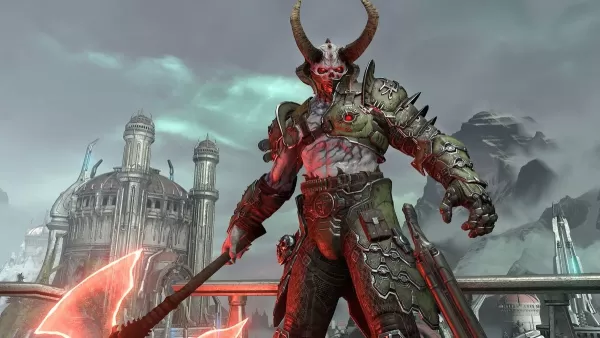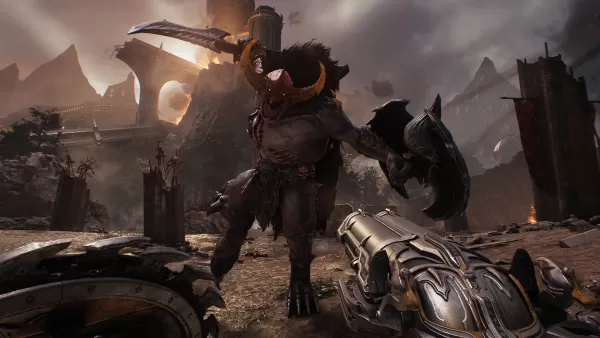When director Hugo Martin unveiled the "stand and fight" mantra for Doom: The Dark Ages during Xbox's Developer Direct, it immediately captured my attention. This approach starkly contrasts with the relentless, fast-paced combat of Doom Eternal, which thrived on constant movement. Yet, amidst Eternal's frenetic battles, the Marauder—a highly controversial enemy—demands players to adopt a "stand and fight" strategy. While many players detest the Marauder, I find its challenge exhilarating. My enthusiasm for Doom: The Dark Ages surged upon discovering that its combat revolves around reacting to bright green lights, a mechanic central to defeating the Marauder.
Rest assured, Doom: The Dark Ages doesn't confine you to a frustrating cage match akin to Eternal's Marauder encounters. While the game introduces the Agaddon Hunter, equipped with a bulletproof shield and a lethal combo attack, the essence of Eternal's battles permeates every enemy in The Dark Ages. The developers have reimagined, refined, and integrated the Marauder's concepts into the core combat system, resulting in battles that carry the strategic depth of a Marauder confrontation without the same level of frustration.
The Marauder stands out in Doom Eternal's fast-paced arena. Typically, players navigate the battlefield, swiftly dispatching weaker enemies while juggling engagements with larger threats. Doom Eternal often feels like a management game, requiring players to juggle speed, space, and weaponry. The Marauder, however, disrupts this flow, demanding undivided attention, often in one-on-one scenarios. When it appears amidst larger fights, the best strategy is to evade its attacks, clear other enemies, and then focus on it exclusively.
 Doom Eternal's Marauder is one of the most controversial enemies in FPS history. | Image credit: id Software / Bethesda
Doom Eternal's Marauder is one of the most controversial enemies in FPS history. | Image credit: id Software / Bethesda
"Standing and fighting" doesn't mean staying static in Doom Eternal. It's about mastering the battlefield through strategic positioning. Approach too closely, and the Marauder's shotgun blast becomes nearly unavoidable. Stay too far, and you'll face a barrage of projectiles, though easier to dodge, keeping you out of range for his axe swing. The key moment is during the axe's wind-up, the only time the Marauder's shield drops, leaving him vulnerable. When his eyes flash bright green, you have a brief window to strike.
This bright green signal is also crucial in Doom: The Dark Ages. Paying homage to the original Doom, demons unleash volleys of projectiles, among which are green missiles that can be parried using the Doom Slayer's new shield, sending them back at their source. Initially, this mechanic serves a defensive purpose, but as you unlock the shield's rune system, parrying becomes a potent offensive tool, stunning enemies or triggering an auto-targeting cannon mounted on your shoulder.
Navigating the battlefields of The Dark Ages involves a series of focused one-on-one skirmishes with various formidable demons. Unlike the Marauder encounters, survival doesn't hinge solely on reacting to green lights; conventional weapons and tactics can lead to victory. However, mastering the shield runes transforms parrying into a vital part of your arsenal. Integrating it into your combat strategy reveals similarities with Eternal's Marauder fights. You need to find the optimal distance, as demons won't launch projectiles at close range, and when green orbs appear, you must position yourself to parry effectively. This focus transforms your journey into a series of strategic, stand-and-fight battles.
The Marauder's primary criticism in Doom Eternal was its disruption of the game's flow. It forced players to abandon familiar tactics. Yet, this deviation is precisely why I appreciate the Marauder—it challenges the ballet-like gameplay of Eternal with a breakdance-style fight. Doom Eternal already broke traditional FPS rules by emphasizing resource management and tactical weapon use. The Marauder further breaks these new rules, presenting the ultimate challenge. While I enjoy this test, I understand why it's polarizing.
 The Agaddon Hunter may be the most Marauder-like enemy in The Dark Ages, but every demon has a little bit of Eternal's most fearsome foe in them. | Image credit: id Software / Bethesda
The Agaddon Hunter may be the most Marauder-like enemy in The Dark Ages, but every demon has a little bit of Eternal's most fearsome foe in them. | Image credit: id Software / Bethesda
Doom: The Dark Ages addresses this issue by incorporating varied combat "dances" into its battles. Each major enemy has unique green projectiles or melee attacks, requiring tailored strategies. For instance, the Mancubus fires wide energy "fences" with green "pillars" at each end, demanding lateral movement to parry successfully. The Vagary sends out volleys of deadly spheres, requiring you to rush towards deflectable rows. The Revenant, resembling the Marauder, remains invulnerable until you parry one of its green skulls.
With every demon demanding unique footwork, encountering new foes feels seamless rather than jarring. The Agaddon Hunter and Komodo present significant challenges with their intense melee combos, but by this point, you're adept at adapting your movement and reactions. This contrasts with the Marauder in Eternal, where players struggled with its position and reaction-based tactics amidst a game focused on weapon choice.
The Marauder's design wasn't flawed; its challenge lay in its unexpected rule-breaking. Doom: The Dark Ages prepares players for similar mechanics by embedding reaction-based combat throughout the game, rather than introducing it abruptly. While this shift makes the challenge less intense—the shield's parry window is more forgiving than the Marauder's eye flash—the core concept remains. Every battle in The Dark Ages echoes the Marauder's essence: locking step, waiting for the perfect moment, and striking when the light turns green. Though presented differently, these ideas are still recognizable and central to the game's combat. In Doom: The Dark Ages, you stand and you fight.
















